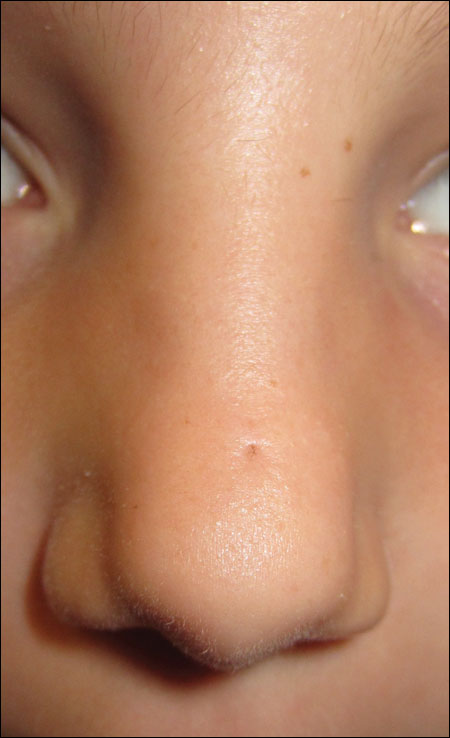A 7-year-old girl presents with a ‘stubborn blackhead’

Erine A. Kupetsky

Andrew C. Krakowski
A 7-year-old girl presented to the pediatric dermatology department with what her mother described as a “stubborn blackhead.” The lesion had been present at birth but only recently had the family noticed “zit material and hairs growing out of it.” After plucking the hairs, the patient’s mother tried “squeezing out the rest of the pus but only a little came out.” The patient was brought to the hospital because the mother is worried that the lesion looks larger, despite the fact that she has been treating it with topical tretinoin 0.025% cream nightly. The patient had a normal, uneventful birth history, and denies any recent fevers, stiff neck or other recent illnesses.
On exam, a small skin-colored, nontender, “pit” is noted on the supranasal tip of the nose, along the midline. Upon closer inspection, there is a single fine hair protruding from the center of the lesion. The lesion is not pulsatile, and does not transilluminate; additionally, there are no signs of inflammation. Notably, the child has no other comedones or acneiform lesions on her face.

Source: Krakowski AC
Click the image to enlarge.
Case Discussion
Dermoid cysts (Question 1, Answer D) are congenital cysts consisting of skin cells, hair follicles and sweat glands. They may occur anywhere in the body, but when they occur in the skin, they are most often found on the face (most commonly at the lateral eyebrow), scalp or neck. Dermoid cysts are slow-growing and, consequently, may go unnoticed until the child is older (aged older than 10 years) or until the lesion becomes “inflamed” secondary to local trauma or infection. These cysts may contain a thick, white exudate similar to a “pimple,” and may be associated with a pit or sinus tract that connects them to underlying tissues.
If a dermoid cyst is suspected, especially when located along the midline, the lesion should be imaged with either an MRI or CT to determine the composition of the cyst, potential locations of other cysts, and to rule out any underlying connections (Question 2, Answer C). Dermoid cysts do not resolve on their own, and they are often removed via surgical excision to prevent infection or because of cosmetic concerns.
- For more information:
- Erine A. Kupetsky, DO, is a dermatology resident at Palisades Medical Center, in North Bergen, N.J. She can be reached at eakderm@gmail.com.
- Andrew C. Krakowski, MD, is chief medical officer of DermOne in West Conshohocken, Pa.
